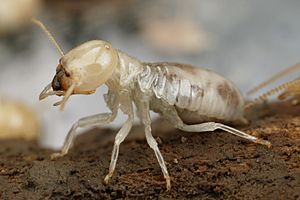Mastotermes darwiniensis facts for kids
Mastotermes darwiniensis, also known as the giant northern termite or Darwin termite, is a special type of termite found only in northern Australia. It's considered the most ancient living termite species, meaning it has kept many features from its very old ancestors.
Quick facts for kids Mastotermes darwiniensis |
|
|---|---|
 |
|
| Scientific classification | |
| Genus: |
Mastotermes
|
| Species: |
darwiniensis
|
Ancient Termite Connections
This termite is super interesting to scientists because it shares many surprising features with cockroaches. Termites and cockroaches are actually very close relatives! For example, the giant northern termite's wings have a similar shape to cockroach wings. Also, unlike most termites that lay eggs one by one, this termite lays its eggs in bunches, just like cockroaches do.
Mastotermes darwiniensis is the only living member of its group, called Mastotermes, and its family, Mastotermitidae. However, many fossils of similar ancient termites have been found. Scientists believe that termites, cockroaches, and their relatives all come from a common ancestor. They are now grouped together in a larger family called Dictyoptera.
Scientists think this termite evolved from the same ancestors as certain wood cockroaches, like Cryptocercus, way back in the Permian period. This was about 250 to 300 million years ago! Fossil wings found from that time in Kansas look very much like the wings of Mastotermes. This ancient fossil, called Pycnoblattina, could fold its wings in a special way. Mastotermes is the only living insect that still folds its wings in this exact same unique way.
Life Cycle and Habits
Unlike cockroaches, only the adult termites that are ready to reproduce have wings. These wings are much longer than their bodies. Adult winged termites, called alates, are about 35 millimeters (1.4 inches) long. Their wingspan can reach up to 50 millimeters (2 inches). Soldier termites, which protect the colony, are about 11–13 millimeters long. Worker termites, who do most of the work, are 10–11.5 millimeters long.
Normally, Mastotermes darwiniensis colonies are not very large or numerous in nature. But if they find lots of water, like from regular watering systems, and good food sources, their populations can explode! They can number in the millions and quickly destroy their surroundings.
These termites eat almost anything organic. This includes introduced plants, damaged ivory, leather, wood, and other natural debris. They can become a big problem for farmers in Northern Australia. In some areas, growing vegetables has almost stopped because these termites are so common. They can even bore into a living tree and chew around its trunk, causing it to die. This dead tree then becomes the perfect home for a new termite colony.
M. darwiniensis is also famous for being the only known host of a tiny living creature called Mixotricha paradoxa. This tiny organism is amazing because it has many different types of bacteria living inside it, all working together!
See also
 In Spanish: Termita gigante del norte de Australia para niños
In Spanish: Termita gigante del norte de Australia para niños

